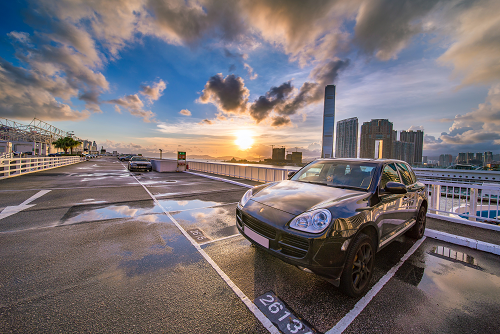
Secure Parking Facilities
Whether an organization owns a parking structure or provides parking facilities to employees through a third party, there are associated risks. In addition to slips and falls, parking structure users are vulnerable to auto accidents, theft, harassment and assault. Parking lots and structures typically have lax security, making protection difficult. Thankfully, numerous measures can lessen these risks—measures employers should look for when using a third party for their parking needs.
Design
Reducing the risks associated with parking structures and parking lots can begin as early as the initial design phase.
Stairwells and elevators should be located in areas readily visible to an attendant, on-site security officer or the general public. If possible, elevators and stairwells should have glass incorporated into their construction for improved visibility; onlookers can easily assess an incident and provide the appropriate help.
Install cylindrical concrete supports instead of square ones to allow drivers to more easily see around corners. Speed bumps placed on long straightaways can prevent drivers from speeding.
A strong parking structure design encourages a pedestrian’s natural surveillance—one’s ability to observe and assess his or her surroundings. This can help prevent auto accidents and deter potential criminals.
Various strategies can improve natural surveillance in parking structures. Some approaches include constructing high ceilings, trimming shrubbery that obstructs views, creating sightlines from the parking structure to the street, and limiting the number of entrances and exits.
Signage
Posting different types of signage in and around a parking structure can also bolster overall safety. For instance, stop signs strategically placed around turns or long straightaways can limit accidents by slowing down drivers.
In addition, signage can clearly direct pedestrians to important safety items—exits, elevators, emergency phones, fire extinguishers—or away from the path of vehicles. Each floor should be clearly labeled, allowing pedestrians to move in and out of the structure quickly and safely.
Use a large font and bold colors for signage to ensure they’re visible and easy to read.
Lighting
Proper lighting can reduce the risk of theft, harassment and assault, as it eliminates potential hiding places.
Parking facilities shouldn’t have dark areas and heavily trafficked areas should be well-lit. The structure or lot should be illuminated by at least two sources of light. Lighting should consider:
· Intensity. Avoid soft lighting. Most parking facilities utilize metal halide lighting, as it’s bright and easy on the human eye.
· Uniformity. Overlapping areas of light is recommended. This helps ensure there are no major shadows. Garage and lot perimeters should also be illuminated.
Access Control
Many employers look for access control measures—automatic gates, card access, etc.—when considering parking structure and lot safety.
Many parking facilities utilize a ticketing system that requires patrons to purchase access to parking. While this doesn’t completely eliminate access to the general public, it does provide a paper trail that law enforcement can use in the event of an incident.
Fencing around the perimeter of a lot or in private areas of a structure is also useful for controlling access and reducing trespassing. It can close off potential hiding areas, such as gaps under stairwells or dark corners in lobbies. These barriers are typically concrete blocks or chain-link fencing.
Surveillance and Security Measures
Active security systems are often the best option for parking structures. A number of surveillance and security measures are available, including:
· Security personnel. Simply having a uniformed security officer on site can be enough to deter potential criminals. To be effective, patrol officers should vary their routes and schedules to avoid creating predictable gaps in coverage.
· Closed circuit television (CCTV). CCTV creates an instant record of incidents, such as theft, assault or auto accidents. Because CCTV is dependent on visibility, appropriate lighting measures need to be in place for effective surveillance. In addition, without a proper response plan in place, CCTV can be a wasted expense. Ensure staff is trained on what to do when an incident occurs.
· Emergency phones and intercoms. Easy access to emergency phones and intercoms is critical if a patron is under attack or if there is another emergency. These systems are best installed in well-lit and easy-to-reach areas near elevators, lobbies, stairs and parking spots.
For added safety, include signage that clearly states the area is under surveillance. This can be a strong deterrent.
General Upkeep
When a parking facility is littered with garbage, it appears as though no one is responsible and surveillance is lax. Regularly inspect the facility, cleaning debris and removing abandoned vehicles when applicable.
Maintenance crews should trim shrubbery and ensure bushes and tree branches don’t block any sightlines. This promotes natural surveillance and eliminates potential hiding spots.
Snow Removal
Prompt removal of ice and snow greatly reduces the risks of slips and falls. Keep in mind:
· Never pile snow on top of a parking structure, as this puts too much strain on the supports and can cause a collapse. Dump snow safely over the sides of the parking structure or into trucks and remove from premises.
· Snowplows can damage concrete. Leave the blade at least half of an inch above the concrete surface.
· Never plow near any of the parking garage’s joints or curbs, as this can damage supports and lead to structural issues. Clearly label these areas, especially if a third party does snow removal.
· Use sand for removing ice. Too many de-icing agents and chemicals aren’t effective during extreme cold.
Use “wet floor” signage in areas where fall hazards are prevalent. Immediately repair any concrete cracks to reduce falls.
Mitigating Risk Starts Early On
Professional risk assessments can help identify major risk areas and provide strategies for addressing potential hazards. These should be done early on to ensure owners are proactive instead of reactive. Keep patrons safe by knowing what hazards to anticipate and how to address them.
Categories: Sin categorizar
Tags: coverage, facilities, liability, parking
